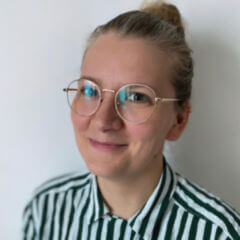Corpus: Myocardium
Achtung: Du siehst nicht die aktuelle, sondern eine ältere Version dieser Seite.
This text has been translated by an AI and may sound raw. It will be reviewed shortly. Thank you for your patience!
This text has been translated by an AI and may sound raw. It will be reviewed shortly. Thank you for your patience!
Synonym: myocardial tissue
1. Definition
The myocardium is the layer of cardiac muscle tissue located between the endocardium (the inner lining of the heart) and the epicardium (the outer lining of the heart). It also includes the papillary muscles and trabeculae carneae located in the cardiac lumen.
2. Classification
2.1. ...according to function
The myocardium is divided into:
- working muscles (working myocardium)
- Muscle cells that belong to the excitation generation and conduction system
2.2. ...according to localization
- Atrial myocardium: Musculature of the atria
- Ventricular myocardium or ventricular myocardium: musculature of the ventricles
3. Anatomy
The myocardial cells are connected to each other to form myocardial fibers, which are combined into visible bundles by endomysial bundles. These bundles run circularly, obliquely and longitudinally, so that a concentric contraction of the ventricles and a longitudinal shortening between the valve level and the apex of the heart is possible.
3.1. Atria
The muscle fibers of the atria form two layers:
- Outer layer: runs horizontally on the front and connects both atria to each other (fasciculus interauricularis horizontalis), on the back some fibres cross the sulcus interatrialis and thus also connect the right atrium to the left atrium (fasciculi transversi)
- Inner layer: horseshoe-shaped muscle tracts (fasciculi verticales) remain limited to the respective atria, clearly visible on the inside of the right atrium (musculi pectinati, crista terminalis)
3.2. Ventricles
The fibers of the ventricles run in a helical pattern and form two layers in the right ventricle and three layers in the left ventricle.
3.2.1. Subepicardial layer
Circularly arranged fibers of the right ventricle continue via the anterior interventricular sulcus to the left ventricle. The muscle bundles run almost longitudinally on the diaphragmatic facies and descend obliquely on the lateral and anterior wall. At the apex of the heart, the subepicardial layer forms a vortex (vortex cordis). In the area of the conus arteriosus, the fibers are attached to the conus tendon.
3.2.2. Mittelschicht
The middle layer exists only in the left ventricle and in the interventricular septum. The fibers run circularly.
3.2.3. Subendocardial layer
The fibres of the subendocardial layer form the innermost muscle layer of both ventricles. They run predominantly longitudinally. This layer is most strongly developed in the area of the papillary muscles. They also cover the interventricular septum on both sides.
4. Histology
Like the skeletal musculature, the myocardium is striated. Morphologically, it occupies an intermediate position between the smooth musculature and the skeletal musculature. The tissue consists of individual mononuclear or binuclear cells, the cardiomyocytes, which form a functional syncytium. In contrast to the peripherally located nuclei of the skeletal muscles, however, the cell nucleus is located centrally.
The cell body of the cardiac muscle cells is branched and the cell network is arranged in a braided pattern. The cells are connected to each other by so-called intercalary discs. Through the gap junctions they contain, they ensure the propagation of excitation between the cardiac muscle cells. They also contain desmosomes and fasciae adhaerentes to stabilise the cell network and transmit force.
Like the skeletal musculature, the myocardium has a regular structure of special striated muscle fibres. It also has a system for rapid calcium influx in the form of terminal cisterns of the sarcoplasmic reticulum and T-tubules of the cell membrane. In contrast to the triads of the skeletal musculature, the myocardium contains units consisting of a terminal cisterna and a T-tubule, so-called diads.
Specialized cardiac muscle cells exist in the sinus node, AV node and in the conduction bundle of the ventricles. The pacemaker cells have only a loose myofibrillar system and no T-tubules. The Purkinje fibers are significantly larger cardiac muscle cells with a lot of glycogen and few myofibrils.
Some cardiomyocytes of the atrium synthesize and store secretory granules. These contain the hormone ANP (atrial natriuretic peptide), which is secreted when the atrial muscles are stretched.
5. Regeneration
Myocardium that has been destroyed (e.g. as a result of a heart attack) is not replaced by functionally equivalent tissue, but by connective tissue (myocardial remodeling).
According to current knowledge, however, the myocardium is also capable of renewing itself to a limited extent. This has been demonstrated by 14C analyses of cardiomyocyte DNA. According to this, around 1% of heart muscle cells are replaced per year in a 25-year-old. This rate drops to 0.45% in 75-year-olds. During a lifetime, however, less than 50% of cardiomyocytes are replaced.[1]
6. Source
- ↑ Bergmann O et al. Evidence for Cardiomyocyte Renewal in Humans, Science 03 Apr 2009:Vol. 324, Issue 5923, pp. 98-102, retrieved 17 Sep 2019



